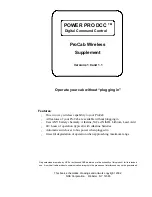
About your wireless Procab:
The Procab-R is designed to eliminate the need for tethered operation of an NCE ProCab. All
present and planned features of the cab are usable while untethered from the cab bus. The
adapter is battery powered and will supply power for both cab operation and the adapter itself.
Although the installed wireless adapter is designed to operate at any voltage from 2 to 16 volts we
recommend the use of 4 AAA cells. The ProCab has a built in battery chamber for 4 AAA battery
cells. The transmitter power of the Procab is .00035 Watts. By comparison your cell phone can put
out 3 Watts or about 10,000 times the power of the ProCab. For this reason a general discussion
of wireless communications follows.
Wireless communications:
We are continuously asked about the operating distance of the wireless cab. There are many
factors governing the useful range of wireless products. The Procab-R operates in the ISM
(Industrial, Scientific and Medical) radio band at 916.5 MegaHertz (Mhz). Many cordless phones,
wireless computer networks, home automation systems, and wireless security devices also operate
in this portion of the radio band and all contribute to radio interference. In any radio system,
propagation of the radio signal will suffer in the presence of ‘in band’ intererence. When devices
operate in the same frequency band they may contribute interference to the point where your cab
may not work at all. On the other hand your wireless cab may interfere with the operation of the
other devices you already own. Radio waves are like one big telephone ‘party line’ where everyone
is talking at once. A device using these radio waves must attempt to sort out what ‘voices’ are
relevant to its operation and which ones are ‘noise’. If there is too much noise it can’t do this
successfully and will operate poorly or not at all.
This is especially prevalent in Arenas and
convention Centers
due to multiple cell phone repeaters and security devices
.
Indoor radio propagation is an issue for special consideration. The human body readily absorbs RF
energy in the frequency band used by the cab radio. Placement of the base station can mitigate
blocking of the radio signal due to human body absorption. In most indoor situations ‘dead spots’
can be found where reception is very difficult. These can occur even if there appears to be a direct
line of sight between the transmitter and receiver. These dead spots, or ‘nulls’, are the result of
multiple radio transmission paths between two points caused by reflections off metal objects such
as steel beams, screen wire, concrete rebar, metal door and window frames, ceiling tile frames,
model railroad track, etc. Nulls occur where the path lengths differ by an odd ½ wavelength (about
6 inches at 900 MHz). Deep nulls are usually very localized and can be avoided by moving slightly,
usually only a few inches. When performing complex tasks involving many messages displayed on
the ProCab, communications between the cab and command station may take longer than
expected thus slowing down your programming. In these instances you may find it more expedient
to plug in the cab while doing extensive programming or system setup.
Operation of the Cab:
To turn on the cab:
Press “EMERGENCY STOP”. The display will activate and show the ‘version message’ but the
backlight of the LCD display will not be on. The ‘version message’ will not disappear until the cab
successfully communicates with the RB01 base station. After the cab communicate s with the base
station normal operations can begin just as if you were plugged in to the cab bus.
Description of LED activity:
The LED on top of the cab will flicker every time it commun icates with the base station. A regular
‘pulse’ of this LED indicates good quality communications. The flickering will become erratic when
you are getting out of range from the base station. You can use this LED activity to ‘map out’ weak
signal areas and ‘nulls’ of the layout room.
Priority is placed on commands getting from the cab to the base station. As you approach the
maximum range of the cab, updates to the LCD display will lag behind the commands being sent to
the base. If the base station is not able to complete sending display updates it will try to re-send
them 16 times before giving up. The base station LEDs flash brightly when it is trying to send
display update information.
Updating the LCD:
If you turn the cab on and the “NCE WIRELESS 1.0” text is not replaced by the normal cab display
press “ENTER” to refresh the display on your cab with the ‘normal’ display information.
To turn off the cab:
Press “EXPN” and select option #1 (TURN CAB OFF).
Automatic shutdown:
As it comes from the factory, the cab will automatically shut itself off after 5 munites of inactivity.
This time can changed from 1 to 9 minutes by pressing “EXPN” and selecting option #2 (SETUP
**Last revised: 6 October 2003
Page 2
ProCab wireless supplement






















